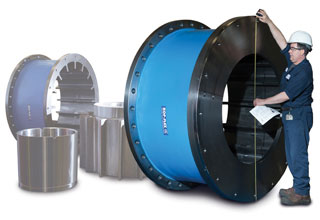Featuring extremely high torque ratings and torsional vibration management, Kop-Flexx Max-C WB hybrid couplings from Emerson Power Transmission, Florence, Ky., combine a maintenance-free, non-lubricated Max-C resilient coupling half with a lightweight diaphragm, disc or high-performance gear coupling half, depending on the application.
They are best suited for drivetrains powered by synchronous motors, variable-frequency drives, and diesel engines, or those driving reciprocating machinery or handling shock loads, such as ID/FD fans, torque converters, marine gears, drill rigs, crushers, kiln drives, mill pinions, ship thrusters, centrifugal compressors, and feed rolls.
Because of its hybrid design, it offers the low-cost, lightweight flexibility of a coupling half for the driven shaft, as well as the vibration-damping of a Max-C coupling half on the motor end. The maintenance-free Max-C dampens high drivetrain torque loads, while the overall hybrid design reduces weight, cost and inertia, eliminating the need for oversized and costlier drivetrain components.
Various designs of the engineered hybrid coupling are capable of transmitting up to 56 million lb-in (6383 kN-m) torque.
The Max-C coupling consists of an outer sleeve with a bladed ID, an inner flex hub with bladed OD, and resilient drive blocks that fill cavities formed when the sleeve and hub are mated. A special Wedge Block cavity design formed by the blades is filled with incompressible elastomer blocks with a Shore “A” hardness of up to 80, allowing tailoring of the block compound for hardness, chemical resistance and temperature resistance. The blocks typically last five years or more and are easily replaced, which makes the coupling “like new.”
Their design is also “fail engage.” If an elastomer block fails for any reason, the coupling will briefly transmit torque through the metal-to-metal contact of the interlocking blades which would allow the user to immediately power down the equipment in a controlled manner. They also withstand wet, gritty and hot environments.
Emerson Industrial Automation
www.emerson-ept.com
